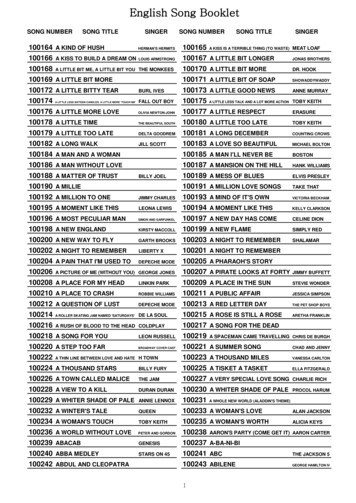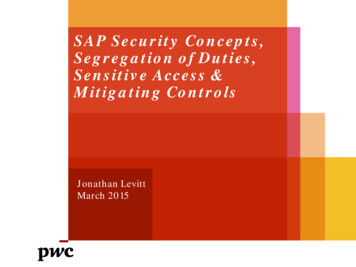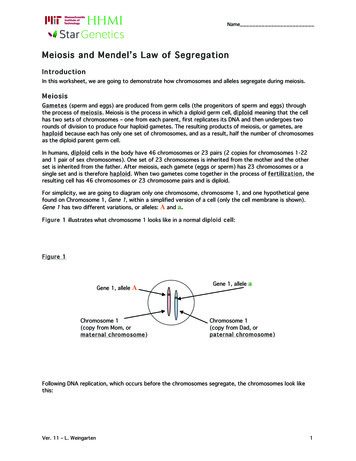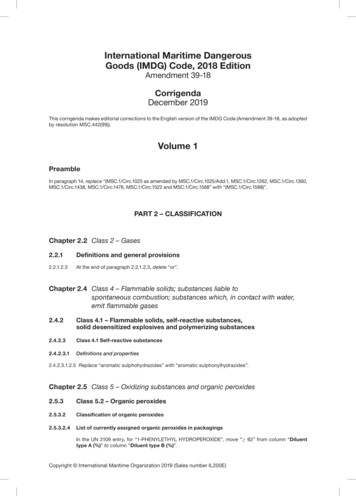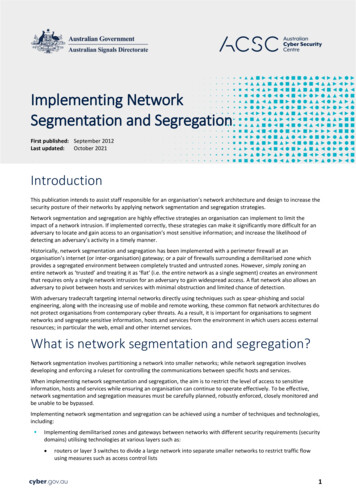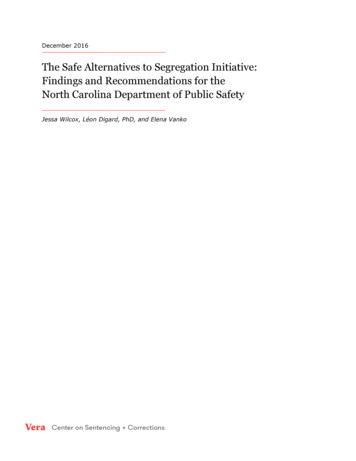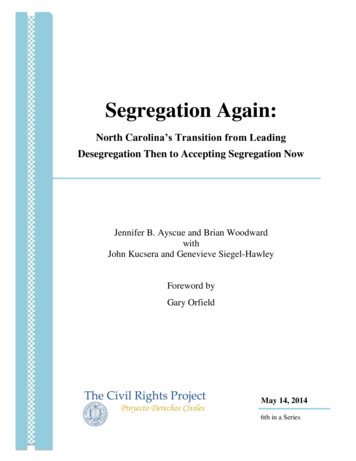
Transcription
Segregation Again:North Carolina’s Transition from LeadingDesegregation Then to Accepting Segregation NowJennifer B. Ayscue and Brian WoodwardwithJohn Kucsera and Genevieve Siegel-HawleyForeword byGary OrfieldMay 14, 20146th in a Series
Segregation Again:NORTH CAROLINA’S TRANSITION FROM LEADINGDESEGREGATION THEN TO ACCEPTING SEGREGATION NOWJennifer B. Ayscue and Brian Woodwardwith John Kucsera and Genevieve Siegel-HawleyForeword by Gary OrfieldMay 14, 2014
SEGREGATION AGAINTHE CIVIL RIGHTS PROJECT/PROYECTO DERECHOS CIVILESMAY 14, 2014Table of ContentsAcknowledgements . iiList of Figures . iiiList of Tables . ivForeword. vExecutive Summary .viiBackground and Context . 1Segregation and Desegregation: What the Evidence Says . 25Data and Methods . 29State Trends . 31Metropolitan Trends . 40Conclusions . 76Recommendations . 78Appendix A: Additional Data Tables . 83Appendix B: Data Sources and Methodology . 103
SEGREGATION AGAINTHE CIVIL RIGHTS PROJECT/PROYECTO DERECHOS CIVILESMAY 14, 2014AcknowledgementsWe are extremely grateful to Gary Orfield and Genevieve Siegel-Hawley for sharing theirexpertise by providing helpful guidance, invaluable feedback, and continued support throughoutour work on this report. We also want to thank John Kucsera for his productive assistance withdata collection and analysis. We would like to acknowledge Charles Clotfelter, Mark Dorosin,Elizabeth Haddix, Roslyn Mickelson, and Dana Thompson Dorsey for sharing their knowledgeand providing helpful suggestions for this report. In addition, we want to express ourappreciation to Laurie Russman, coordinator of the Civil Rights Project/ Proyecto DerechosCiviles, for her encouraging support and editorial assistance.This report is the sixth in a series of 13 reports from the Civil Rights Project analyzing schoolsegregation trends in the Eastern states.ii
SEGREGATION AGAINTHE CIVIL RIGHTS PROJECT/PROYECTO DERECHOS CIVILESMAY 14, 2014List of FiguresFigure 1 – Public School Enrollment by Race, North Carolina . 32Figure 2 – Black Students in Minority Segregated Schools, North Carolina . 34Figure 3 – Latino Students in Minority Segregated Schools, North Carolina . 35Figure 4 – Students in Multiracial Schools by Race, North Carolina . 36Figure 5 – White Students in School Attended by Typical Student of Each Race, North Carolina. 37Figure 6 – Racial Composition of School Attended by Typical Black Student, North Carolina . 38Figure 7 – Racial Composition of School Attended by Typical Latino Student, North Carolina . 38Figure 8 – Racial Composition of School Attended by Typical Student by Race, North Carolina39Figure 9 – Exposure to Low-Income Students by Race, North Carolina . 40Figure 10 – Public School Enrollment by Race, Charlotte Metro . 42Figure 11 – Black Students in Minority Segregated Schools, Charlotte Metro . 45Figure 12 – Latino Students in Minority Segregated Schools, Charlotte Metro . 45Figure 13 – Students in Multiracial Schools by Race, Charlotte Metro . 46Figure 14 – White Students in School Attended by Typical Student of Each Race, Charlotte Metro. 47Figure 15 – Racial Composition of School Attended by Typical Black Student, Charlotte Metro 47Figure 16 – Racial Composition of School Attended by Typical Student by Race, Charlotte Metro. 48Figure 17 – Exposure to Low-Income Students by Race, Charlotte Metro . 49Figure 18 – Racial Transition by District, Charlotte Metro . 50Figure 19 – Degree and Type of Racial Transition, Charlotte Metro, 1999 to 2010 . 52Figure 20 –Rapidly or Moderately Transitioning Districts, Charlotte Metro, 1989 to 2010 . 53Figure 21 – Public School Enrollment by Race, Raleigh Metro. 54Figure 22 – Black Students in Minority Segregated Schools, Raleigh Metro . 57Figure 23 – Latino Students in Minority Segregated Schools, Raleigh Metro . 57Figure 24 – Students in Multiracial Schools by Race, Raleigh Metro . 58Figure 25 – White Students in School Attended by Typical Student of Each Race, Raleigh Metro. 59Figure 26 – Racial Composition of School Attended by Typical Black Student, Raleigh Metro. 59Figure 27 – Racial Composition of School Attended by Typical Student by Race, Raleigh Metro. 60Figure 28 – Exposure to Low-Income Students by Race, Raleigh Metro. 61Figure 29 – Racial Transition by District, Raleigh Metro . 62Figure 30 – Degree and Type of Racial Transition, Raleigh Metro, 1999 to 2010 . 63Figure 31 – Public School Enrollment by Race, Greensboro Metro . 64Figure 32 – Black Students in Minority Segregated Schools, Greensboro Metro . 67Figure 33 – Latino Students in Minority Segregated Schools, Greensboro Metro . 67Figure 34 – Students in Multiracial Schools by Race, Greensboro Metro . 68Figure 35 – White Students in School Attended by Typical Student of Each Race, GreensboroMetro . 69Figure 36 – Racial Composition of School Attended by Typical Black Student, Greensboro Metro. 69Figure 37 – Racial Composition of School Attended by Typical Student by Race, GreensboroMetro . 70iii
SEGREGATION AGAINTHE CIVIL RIGHTS PROJECT/PROYECTO DERECHOS CIVILESMAY 14, 2014Figure 38 – Exposure to Low-Income Students by Race, Greensboro Metro . 71Figure 39 – Racial Transition by District, Greensboro Metro . 72Figure 40 – Degree and Type of Racial Transition, Greensboro Metro, 1999 to 2010 . 74Figure 41 – Rapidly or Moderately Transitioning Districts, Greensboro Metro, 1989 to 2010. 75List of TablesTable 1 – Public School Enrollment, North Carolina, the South, and the Nation . 31Table 2 – Multiracial and Minority Segregated Schools, North Carolina . 33Table 3 – Students Who Are Low-Income in Minority Segregated Schools, North Carolina . 34Table 4 – Public School Enrollment by Race in Urban and Suburban Schools, Charlotte Metro43Table 5 – Multiracial and Minority Segregated Schools, Charlotte Metro . 43Table 6 – Students Who Are Low-Income in Minority Segregated Schools, Charlotte Metro . 44Table 7 – Entropy Index Values, Overall and Within and Between School Districts, CharlotteMetro . 49Table 8 – White Proportion and Classification in Metropolitan Area and School Districts,Charlotte Metro . 51Table 9 – Public School Enrollment by Race in Urban and Suburban Schools, Raleigh Metro . 55Table 10 – Multiracial and Minority Segregated Schools, Raleigh Metro . 56Table 11 – Students Who Are Low-Income in Minority Segregated Schools, Raleigh Metro. 56Table 12 – Entropy Index Values, Overall and Within and Between School Districts, RaleighMetro . 61Table 13 – White Proportion and Classification in Metropolitan Area and School Districts,Raleigh Metro . 62Table 14 – Public School Enrollment by Race in Urban and Suburban Schools, GreensboroMetro . 65Table 15 – Multiracial and Minority Segregated Schools, Greensboro Metro. 66Table 16 – Students Who Are Low-Income in Minority Segregated Schools, Greensboro Metro 66Table 17 – Entropy Index Values, Overall and Within and Between School Districts, GreensboroMetro . 71Table 18 – White Proportion and Classification in Metropolitan Area and School Districts,Greensboro Metro . 73iv
SEGREGATION AGAINTHE CIVIL RIGHTS PROJECT/PROYECTO DERECHOS CIVILESMAY 14, 2014ForewordNorth Carolina matters. It is an increasingly diverse and growing state with a promisingfuture and some deep political and social divisions. It was deeply changed by the civil rightsrevolution and was one of the fortunate states that had county-wide school districts, whichproved to be the most successful in the desegregation process, creating lasting diversity andhelping to diminish residential divisions that are so characteristic of metropolitan areas dividedinto many separate school districts where most of the middle-class population has littleawareness of the conditions in the poorer areas and little concern about their future. NorthCarolina is still less segregated than the United States as a whole.The Charlotte Swann decision opened up a new era in school integration and also in thepolitics of civil rights, as presidential candidate Richard Nixon attacked the court and PresidentNixon changed the position of the federal civil rights agencies, opposing urban integration. TheSwann case, which required historically segregated communities to achieve integration even ifpupil transportation was required, was the key to desegregating the students of the urban Southand produced changes in scores of cities in a very short period. Charlotte-Mecklenburg, WakeCounty, and other North Carolina districts persisted through the political and legal storms andachieved a level of urban desegregation rarely seen elsewhere in the United States for severaldecades.I had the opportunity to visit North Carolina communities and schools several timesduring this experience and closely followed the reports of the Swann Fellowship, the UNCCenter for Civil Rights and others involved in this work. We cosponsored a remarkable meetingin Chapel Hill in 2002 where several hundred educators, community activists, and scholarsgathered to discuss new research on civil rights and the future of the South, leading to the UNCPress book, School Resegregation: Must the South Turn Back? It was a sign of the deep progressin the state when the leaders of Charlotte-Mecklenburg invested heavily in fighting to continuetheir desegregation process, confessing that the district still had much to do to create genuinelyequal education, and a sign of the deep retreat of the federal courts, remade by conservativejudicial appointments, when the federal courts refused their appeal and, in effect, ordered them toresegregate. When it became apparent that the Fourth Circuit Court of Appeals was going todissolve desegregation orders, Wake County impressively developed ways to maintainconsiderable diversity in their schools by considering the poverty and the test scores of studentsand preventing the concentration of poor, low-scoring students in schools. The way in which theissue was politicized there and the way in which the community responded in the subsequentelection as well as the racial implications were significant. The community rejected the leaderswho had ended the county's desegregation effort but has yet to come up with a new plan to fosterdiversity.In the history of the Civil Rights Project, we have been blessed with a succession ofyoung researchers from the South who have experienced diverse education and some of whomhave been teachers in diverse schools. When I moved the Civil Rights Project from Harvard toUCLA, I was worried about whether this tradition would continue on the other coast. Fortunatelyit has, and we were extremely lucky to have two young researchers who were educated in NorthCarolina, who taught in North Carolina, and who love their state, to work on this report. I hopethat citizens and educators of the Tar Heel State will look carefully and think deeply about thetrends we report here and their implications for the future of what now is a deeply tri-racial statev
SEGREGATION AGAINTHE CIVIL RIGHTS PROJECT/PROYECTO DERECHOS CIVILESMAY 14, 2014which has lost most of the tools created by the civil rights revolution. It is very sad for me to seestatistics showing a level of segregation that looks like Detroit or Chicago in parts of NorthCarolina where there had been nothing like that for a third of a century. In spite of the limitationsthat have now been imposed by narrow majorities on the U.S. Supreme Court, there are stillways, as Wake County has shown, to pursue diversity of the state's communities.The Supreme Court held six decades ago that segregated schools were "inherentlyunequal." Despite what some educators and politicians say today and some of the remarkableefforts in a small set of segregated schools with high test scores, this remains true today. In thenature of things, you cannot learn how to live and work effectively in a profoundly diversesociety in segregated neighborhoods and separate schools. The authors of this report have offeredconstructive, non-coercive policy suggestions that deserve the serious attention of NorthCarolina's educators, policy makers, and citizens. It is true that desegregation is hard butSouthern history proves abundantly that successful segregation on a large scale is impossible.When I was a graduate student, one of my most powerful teachers was the great AfricanAmerican historian John Hope Franklin who spent his later years at Duke University. He taught aseminar that deeply affected me about the way in which the conservative courts and thepoliticians in the late l9th century gutted the rights created for freedmen after the Civil War andled the country into six decades of rigid segregation. There were terrible costs for the South fromso deeply dividing the society and failing to fully develop the human capital of so many of itsstudents. People who think seriously about the history of North Carolina and the fact that theirfuture, more than ever, is dependent upon developing the talents of all of its people in a verymultiracial society, should act to prevent another very serious reversal.Gary Orfieldvi
SEGREGATION AGAINTHE CIVIL RIGHTS PROJECT/PROYECTO DERECHOS CIVILESMAY 14, 2014Executive SummaryNorth Carolina has a storied history with school integration efforts spanning severaldecades. In response to the Brown decision, North Carolina’s strategy of delayed integration wasmore subtle than the overt defiance of other Southern states. Numerous North Carolina schooldistricts were early leaders in employing strategies to integrate schools at a very modest level.When the l964 Civil Rights Act vastly expanded federal power, desegregation accelerated. In1971, Charlotte-Mecklenburg gained national attention in the first Supreme Court decisionmandating busing as a primary strategy to achieve school integration. By 2000, Wake Countypublic schools became the first metropolitan school district to implement a class-based studentassignment policy1, shifting from a race-based student assignment plan. Yet despite initiatingschool diversification efforts for a generation, currently North Carolina has reverted back toneighborhood schools while concurrently adopting policies that deemphasize diversity. Today,the state’s Latino enrollment, which has grown very rapidly in the post-civil rights era, addsanother important dimension to the story. Since racial and economic segregation are stronglyrelated to unequal opportunity, these changes likely have important educational consequences.This report investigates trends in school segregation in North Carolina over the last twodecades by examining measures of concentration, exposure, and evenness by both race and class.After exploring the overall enrollment patterns and segregation trends at the state level, thisreport turns to three major metropolitan areas within the state—Charlotte-Gastonia-Concord,Raleigh-Cary, and Greensboro-High Point—to analyze similar measures of segregation for eachmetropolitan area.Major findings in the report include:North Carolina North Carolina’s public school enrollment has become increasingly diverse over the lasttwo decades. In 2010, the state’s enrollment was 53% white, 26% black, 13% Latino, 3%Asian, 1% American Indian, and 4% mixed, compared to 1989 when the enrollment was67% white, 30% black, 1% Latino, 1% Asian, and 1% American Indian.The share of multiracial schools—those that have any three races representing 10% ormore of the total school enrollment—increased by 1,284%, from 2.6% in 1989 to 36% in2010.During the same time, the share of majority minority schools—those in which 50-100%of the student enrollment is comprised of minority students—almost doubled from 23.8%to 43.0%, and the share of intensely segregated schools—those in which 90-100% of thestudent enrollment is comprised of minority students—tripled from 3.5% to 10.2%.The share of black students attending minority segregated schools has steadily increasedover the last 20 years, such that seven out of 10 of black students attended majorityminority schools and two out of 10 of black students attended intensely segregatedschools in 2010.The share of Latino students attending minority segregated schools has also increasedover the last two decades, such that six out of 10 of Latino students attended majority1Silberman, T. (2002). Wake County schools: A question of balance. Divided we fail: Coming together throughpublic school choice, 141-63. New York: The Century Foundation.vii
SEGREGATION AGAINTHE CIVIL RIGHTS PROJECT/PROYECTO DERECHOS CIVILES MAY 14, 2014minority schools and one out of 10 of Latino students attended intensely segregatedschools in 2010.In 2010, approximately half of all Latino, Asian, and black students attended multiracialschools whereas almost one-third of all white students attended such schools.The gap in exposure of the typical black student to white students versus the overall shareof white student enrollment has grown larger during the last two decades such that in2010, the typical black student attended a school with 34.7% white classmates eventhough the overall white share of enrollment in the state was 53.2%.The same general pattern is true for Latino students, though to a lesser extent. In 2010,the typical Latino student attended a school with 43.3% white classmates compared to theoverall white share of enrollment at 53.2%.The typical white student is exposed to a larger share of other white students (65.8%)than the overall level of white enrollment in the state (53.2%); this gap has also grownlarger over the last 20 years.In 2010, both the typical black student and the typical Latino student attended schoolsthat had larger shares of low-income students (59.1%, 59.1%) than the overall share oflow-income students in the state (50.2%) while the typical white student and the typicalAsian student attended schools with smaller shares of low-income students (43.5%,41.8%) than the overall share of low-income students in the state.Charlotte-Gastonia-Concord Metropolitan Area From 1989 to 2010, metro Charlotte’s white share of enrollment decreased by 28% suchthat in 2010, white students accounted for slightly less than half of the total enrollment(48%); the remainder of the enrollment was 31% black, 14% Latino, 3% Asian, and 4%mixed.Over the last two decades in both urban and suburban schools, the white share ofenrollment has decreased while the Asian and Latino shares of enrollment haveincreased. Black students are the only racial group that has different enrollment trends inurban versus suburban schools with an increase in urban schools and a relatively stablerepresentation in suburban schools.The percentage of multiracial schools has increased considerably over the last twodecades, from 1.4% in 1989 to 36.4% of all schools in 2010.The share of majority minority schools has more than doubled from 22.3% to 51.6% andthe share of intensely segregated schools increased substantially from 0.1% to 20.2%.The share of black students attending minority segregated schools has more than doubledover the last two decades, such that in 2010, three out of four black students in theCharlotte metro attended majority minority schools and one out of three black studentsattended intensely segregated schools.The share of Latino students attending minority segregated schools has also more thandoubled, such that in 2010, two out of three Latino students attended a majority minorityschool and one out of four Latino students attended an intensely segregated school.In 2010, the majority of Latino (53.2%) students attended multiracial schools; for allother racial groups, between 30 and 40% of each group attended a multiracial school.In 2010, the typical black student was least exposed to white students and attended aschool that was only 28.2% white; the gap in the typical black student’s exposure toviii
SEGREGATION AGAINTHE CIVIL RIGHTS PROJECT/PROYECTO DERECHOS CIVILES MAY 14, 2014white students versus the white share of enrollment has grown larger over time. Thetypical Latino student’s school was 32.7% white while the typical white student attendeda school that was 65.1% white.The typical white student is exposed to a smaller share of low-income students (33.6%)than the metro’s average (46.6%) while the typical black student (59.7%) and the typicalLatino student (62.2%) are exposed to larger shares than the metro’s average.The level of segregation in metro Charlotte has increased over the last two decades and iscurrently considered a moderate level of segregation; most of this segregation is due tosegregation within school districts rather than between districts.In 1989, half of the metro’s six enduring districts—those that were open in 1989, 1999,and 2010—were predominantly white (Union County, Gaston County, and CabarrusCounty), two were diverse (CMS and Kannapolis City), and one was predominantlynonwhite (Anson County). By 2010, none were predominantly white, four were diverse(Union County, Gaston County, Cabarrus County, and Kannapolis City) and the othertwo were predominantly nonwhite (CMS and Anson County).Raleigh-Cary Metropolitan Area From 1989 to 2010, the white share of enrollment decreased by 24%, from 69% to 53%,and the black share of enrollment decreased by 16%, from 28% to 23%; during the sametime, both the Latino and Asian shares of enrollment increased, from 1% to 15% forLatinos and from 2% to 5% for Asians.In both urban and suburban schools, the white share of enrollment decreased butremained the largest share of enrollment. The Asian and Latino shares of enrollmentincreased in both urban and suburban schools. The black share of enrollment increased inurban schools but decreased in suburban schools.The share of multiracial schools in metro Raleigh has increased substantially over the lasttwo decades, from 0.9% in 1989 to 69.4% of all schools in 2010.The share of majority minority schools quadrupled from 10.6% to 41.3% while the shareof intensely segregated and apartheid schools remained very small at less than 3%.However, metro Raleigh has a smaller share of majority minority, intensely segregated,and apartheid schools than metro Charlotte and metro Greensboro.The share of black students attending minority segregated schools has more thanquadrupled over the last two decades, such that in 2010, more than half of metroRaleigh’s black students attended majority minority schools. However, only 4.5% ofmetro Raleigh’s black students attended intensely segregated schools in 2010, a muchsmaller share than either metro Charlotte or metro Greensboro.The share of Latino students attending minority segregated schools has also increasedsubstantially, such that in 2010, almost half of the metro’s Latino students attended amajority minority school, but only 2% of Latino students attended intensely segregatedschools.In 2010, between 65% and 82% of students in each racial group attended multiracialschools in metro Raleigh, which is an increase from two decades earlier; in fact, only onedecade earlier, closer to 10-25% of each racial group attended such schools.In 2010, the typical black student was least exposed to white students and attended aschool that was only 43.6% white; the gap in the typical black student’s exposure toix
SEGREGATION AGAINTHE CIVIL RIGHTS PROJECT/PROYECTO DERECHOS CIVILES MAY 14, 2014white students versus the white share of enrollment has grown larger over time. Thetypical Latino student’s school was 47.2% white in 2010 while the typical white studentattended a school that was 58.2% white.The typical white student is exposed to a smaller share of low-income students (30.8%)than the metro’s average (34.7%) while the typical black student and the typical Latinostudent are exposed to larger shares (41.0%, 41.7%) than the metro’s average.The level of segregation in metro Raleigh has increased over the last two decades and iscurrently considered a low level of segregation; most of this segregation is due tosegregation within school districts rather than between districts.In 1989, all of the metro’s three enduring districts—Johnston County, Franklin County,and Wake County—were diverse, and although all three have experienced decreases inthe white share of enrollment over the last two decades, in 2010, all three remaineddiverse.Greensboro-High Point Metropolitan Area From 1989 to 2010, metro Greensboro’s white share of enrollment decreased from 70%to slightly less than half of the total enrollment (49.6%); the remainder of the enrollmentwas 31.0% black, 10.4% Latino, 4.0% Asian, and 3.7% mixed.Over the last two decades in both urban and suburban schools, the white share ofenrollment has decreased while the black, Latino, and Asian shares of enrollment haveincreased.The percentage of multiracial schools has increased considerably over the last twodecades, from 1.4% in 1989 to 30.6% of all schools in 2010.The share of majority minority schools more than doubled from 20.4% to 52.5%, and theshare of intensely segregated schools increased substantially from 0.7% to 15.8%, levelsthat are similar to metro Charlotte but higher than metro Raleigh.The share of black students attending minority segregated schools has doubled over thelast two decades, such that in 2010, eight out of 10 black students in the Greensborometro attended majority minority schools, slightly more than metro Charlotte, and on
Carolina, who taught in North Carolina, and who love their state, to work on this report. I hope that citizens and educators of the Tar Heel State will look carefully and think deeply about the trends we report here and their implications for the future of what now is a deeply tri-racial state
